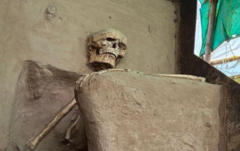A remarkable archaeological find in Gujarat is facing an uncertain future as a 1,000-year-old skeleton, excavated in 2019, continues to be left in a makeshift tent rather than housed in a museum. Initially discovered by archaeologist Abhijit Ambekar, the skeleton was found seated in a meditative posture in Vadnagar and is emblematic of the Solanki period. Despite its importance, it remains without an official home due to ongoing bureaucratic battles.
Ambekar, leading the Archaeology Survey of India (ASI) division in Mumbai, expressed the skeleton’s significance for understanding local ancestry and lifestyles. “This skeleton can uncover living habits and ancient practices in a way we have previously not understood,” he explained. However, political complexities hinder its relocation to the Archaeological Experiential Museum recently opened nearby.
The Gujarat government asserts that proper procedures weren't followed for its transfer from ASI to the museum, which has room for about 9,000 artifacts, yet the skeleton is noticeably absent. This oversight has caused frustration among locals who see the potential impact of showcasing such a unique discovery for tourism and education.
Currently, the remains are housed in a tarpaulin shelter, vulnerable to the elements, while local residents from Vadnagar, notably the birthplace of Prime Minister Narendra Modi, express disappointment over the neglect. Community member Jesang Thakor highlights, “How can such a unique part of our history be left outside? This treatment is deeply concerning.”
The skeleton's excavation was meticulous, involving careful soil removal over two months, and was painstakingly removed from its grave. With plans for a protective museum space in sight, many hope for a swift resolution to the administrative hurdles blocking the skeleton from its rightful place among historical artifacts. Local sentiment strongly favors moving the remains inside a climate-controlled environment to preserve them further.
Experts like Ambekar criticize the lack of urgency in addressing the skeleton's situation. As insights into ancient burial practices are revealed through scientific studies, the pressing need for a dedicated exhibit grows clearer. Ultimately, the community's calls for prompt action reflect a broader yearning for respect towards their historical heritage. “This skeleton can not only reveal our past but help us celebrate and share our culture globally,” noted resident Bethaji Thakor, advocating for prompt measures to ensure the skeleton finds its rightful place.




















